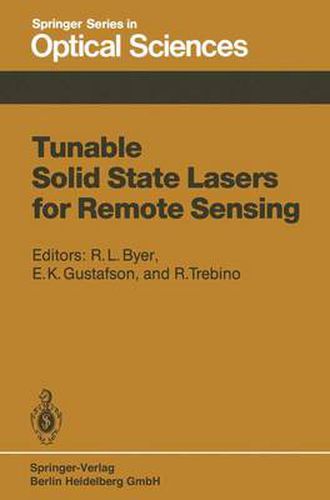Readings Newsletter
Become a Readings Member to make your shopping experience even easier.
Sign in or sign up for free!
You’re not far away from qualifying for FREE standard shipping within Australia
You’ve qualified for FREE standard shipping within Australia
The cart is loading…






This title is printed to order. This book may have been self-published. If so, we cannot guarantee the quality of the content. In the main most books will have gone through the editing process however some may not. We therefore suggest that you be aware of this before ordering this book. If in doubt check either the author or publisher’s details as we are unable to accept any returns unless they are faulty. Please contact us if you have any questions.
The Workshop on Tunable Solid State Lasers for Remote Sensing was held at Stanford University in October 1984 to assess the state of the art in tunable solid state lasers for remote sensing from satellite platforms. The value of conducting global remote sensing measurements of atmospheric chemistry, climate, and weather in the 1990s is now established. What is not yet defined, however, is the status of the developing tunable laser technology that must meet both the scientific requirements and the space platform constraints. This workshop was convened by the Office of Aeronautics and Space Technology (OAST) of the National Aeronautics and Space Administration (NASA) to assess the status and progress in tunable solid state laser sources for remote sensing. The workshop was organized to facilitate information exchange across a number of technologies from remote sensing requirements to crystal growth of the materials important for the development of the tunable laser sources. The emphasis was on the recent developments in tunable solid state laser sources necessary to meet the future transmitter requirements for global remote sensing. A goal of the workshop was to form recommendations to NASA on the current and future prospects for solid state laser technology that will allow remote sensing measurements from air, shuttle, and free-flying satellite platforms. The emphasis was on solid state laser sources because they offer the best potential for meeting the demanding requirements of compact size, good efficiency, and long operational lifetimes required for future space station and free-flying platform operation.
$9.00 standard shipping within Australia
FREE standard shipping within Australia for orders over $100.00
Express & International shipping calculated at checkout
This title is printed to order. This book may have been self-published. If so, we cannot guarantee the quality of the content. In the main most books will have gone through the editing process however some may not. We therefore suggest that you be aware of this before ordering this book. If in doubt check either the author or publisher’s details as we are unable to accept any returns unless they are faulty. Please contact us if you have any questions.
The Workshop on Tunable Solid State Lasers for Remote Sensing was held at Stanford University in October 1984 to assess the state of the art in tunable solid state lasers for remote sensing from satellite platforms. The value of conducting global remote sensing measurements of atmospheric chemistry, climate, and weather in the 1990s is now established. What is not yet defined, however, is the status of the developing tunable laser technology that must meet both the scientific requirements and the space platform constraints. This workshop was convened by the Office of Aeronautics and Space Technology (OAST) of the National Aeronautics and Space Administration (NASA) to assess the status and progress in tunable solid state laser sources for remote sensing. The workshop was organized to facilitate information exchange across a number of technologies from remote sensing requirements to crystal growth of the materials important for the development of the tunable laser sources. The emphasis was on the recent developments in tunable solid state laser sources necessary to meet the future transmitter requirements for global remote sensing. A goal of the workshop was to form recommendations to NASA on the current and future prospects for solid state laser technology that will allow remote sensing measurements from air, shuttle, and free-flying satellite platforms. The emphasis was on solid state laser sources because they offer the best potential for meeting the demanding requirements of compact size, good efficiency, and long operational lifetimes required for future space station and free-flying platform operation.